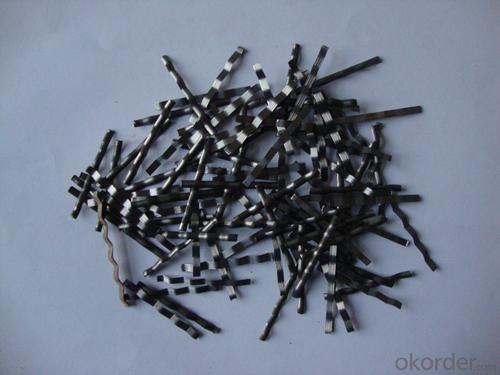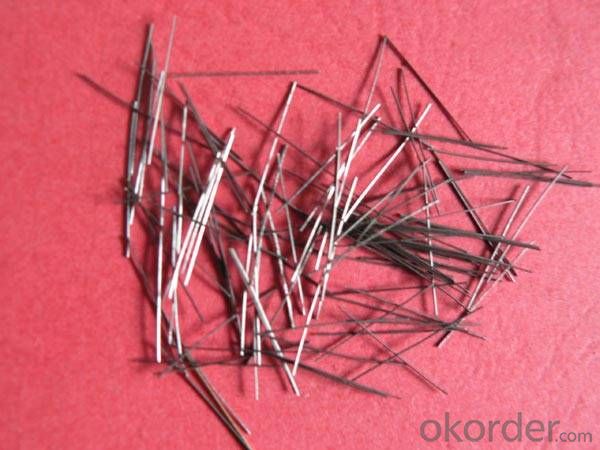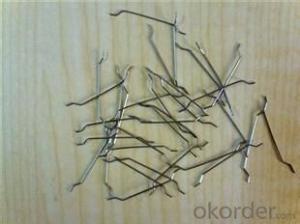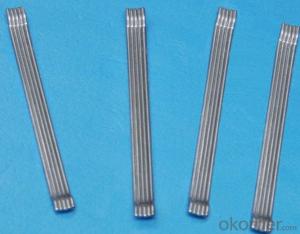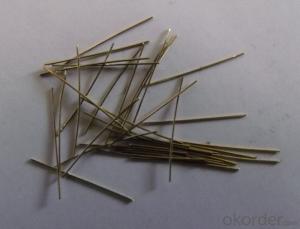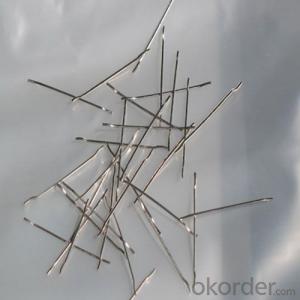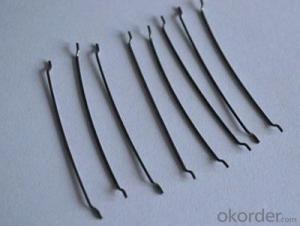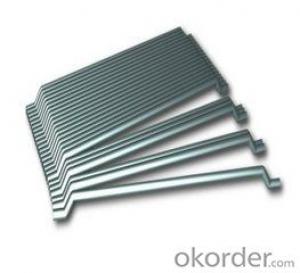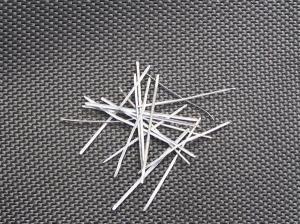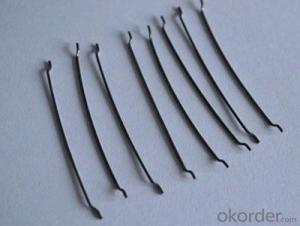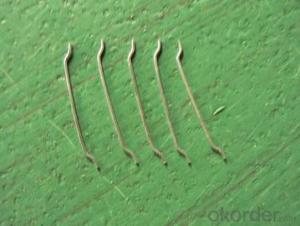Melt Extract Stainless Steel Fiber Straight CNBM International from China
- Loading Port:
- Tianjin
- Payment Terms:
- TT OR LC
- Min Order Qty:
- 1000 kg
- Supply Capability:
- 30000 kg/month
OKorder Service Pledge
OKorder Financial Service
You Might Also Like
Quick Details
| Place of Origin: | Hebei, China (Mainland) | Brand Name: | cnbm | Model Number: | 102 |
| Material: | Stainless Steel | Shape: | hooked ends and straight middle |
Specifications
1.High tensile strength
2.Length 6-60mm
3.Diameter 0.2-1.0mm
1.Diameter:0.5mm-1.0mm
2.Length: 25mm-60mm
3.Material: low carbon steel wire
4.Feature: excellent tensile,high tenacity,against cracking,impact and fatigue
5.Uses: high way,tunnel,building,airport road serface and so on .
| Packaging Details: | 20kgs per paper bag,50 paper bags per pallet(1000Kgs) Carton is available. |
| Delivery Detail: | within 15-25 days after we receive the deposit |
Picture
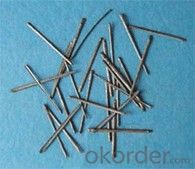
Steel fiber straight type

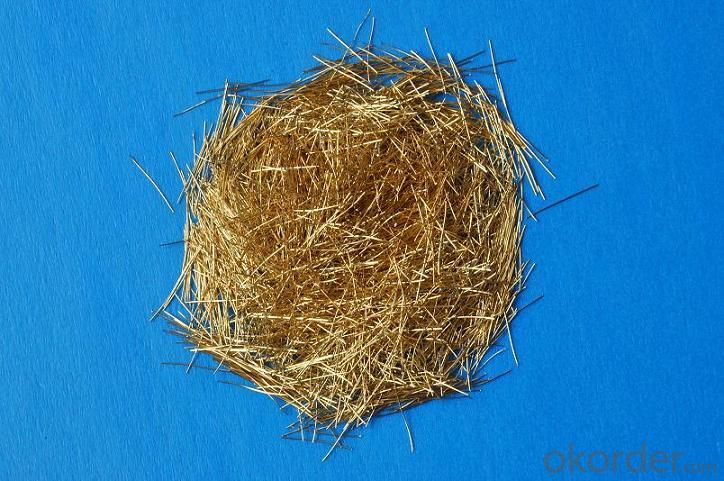
FAQ
certificated: ISO 9001
Technical advantages of Daye steel fiber:
A. Improve mechanical performance of concrete
B. Provide uniform distribution throughout concrete with excellent mixing
C. No balling or caking by adopt correct mixing method
D. Reduce concrete volume
E.Save construction time and cost
F.Reduce excavation volume
G.Available for jointless floor.
- Q: What are the limitations of using melt extract stainless steel fiber in concrete?
- There are several limitations associated with using melt extract stainless steel fiber in concrete. Firstly, one limitation is the high cost of stainless steel fibers compared to other types of reinforcing materials. The manufacturing process of stainless steel fibers involves melting and extracting steel, which adds to the overall production cost. This can make it a less cost-effective option for projects with tight budgets. Secondly, the addition of stainless steel fibers can increase the viscosity of the concrete mix, making it more difficult to handle and place. This can lead to challenges during the construction process, especially when pouring and finishing the concrete. Another limitation is the potential for corrosion if the stainless steel fibers are not properly coated. Stainless steel is known for its corrosion resistance, but in certain environments, such as those with high chloride content, the fibers can still be susceptible to corrosion. This can compromise the durability and longevity of the concrete structure. Furthermore, the effectiveness of stainless steel fibers in controlling cracking may vary depending on the concrete mix design and curing conditions. Achieving the desired crack control properties may require specific fiber dosages and distribution, which can add complexity to the concrete mix design process. Lastly, the addition of stainless steel fibers can affect the aesthetics of the concrete surface. The fibers may be visible on the surface, especially if a smooth finish is desired. This can be undesirable for applications where a visually appealing finish is required, such as architectural concrete. In summary, while melt extract stainless steel fibers offer certain benefits in reinforcing concrete, such as increased crack resistance and improved durability, they also come with limitations including high cost, increased viscosity of the mix, potential for corrosion, variability in crack control effectiveness, and impact on aesthetics. These limitations should be carefully considered when deciding to use stainless steel fibers in concrete applications.
- Q: Can melt extract stainless steel fiber be used in the construction of airport runways?
- Yes, melt extract stainless steel fiber can be used in the construction of airport runways. Stainless steel fibers are commonly used in concrete reinforcement due to their high tensile strength, corrosion resistance, and durability. In the case of airport runways, where heavy loads and frequent aircraft traffic are expected, the addition of stainless steel fibers can enhance the strength and performance of the concrete pavement. The use of melt extract stainless steel fiber in airport runway construction offers several benefits. Firstly, these fibers help to control cracking in concrete, which is crucial for maintaining the integrity and longevity of the runway. By effectively distributing stress throughout the concrete, stainless steel fibers prevent the formation and propagation of cracks, minimizing the potential for spalling, erosion, and other forms of deterioration. Moreover, stainless steel fibers can improve the impact resistance and load-carrying capacity of airport runways. The fibers act as reinforcement, effectively increasing the tensile strength and flexural toughness of the concrete. This reinforcement is particularly important in areas with heavy aircraft traffic, where the runway is subjected to continuous stress and dynamic loads from landing and takeoff operations. Additionally, melt extract stainless steel fibers are highly resistant to corrosion, ensuring the long-term durability of the runway. Stainless steel is known for its ability to withstand harsh environmental conditions, including exposure to deicing salts and chemicals commonly used at airports. This corrosion resistance helps to maintain the structural integrity of the concrete pavement and reduces the need for costly repairs or replacements. In summary, melt extract stainless steel fiber can be successfully utilized in the construction of airport runways. Its ability to control cracking, enhance load-bearing capacity, and resist corrosion makes it an excellent choice for reinforcing the concrete pavement in areas that require high durability and strength, such as airport runways.
- Q: How does melt extract stainless steel fiber affect the crack width of concrete?
- Melt extract stainless steel fiber has a significant effect in reducing crack width in concrete. When incorporated into the concrete mix, these fibers act as reinforcement, enhancing the overall strength and durability of the material. The fibers are evenly distributed within the concrete matrix, forming a three-dimensional network that helps control cracking. The primary way in which melt extract stainless steel fibers reduce crack width is by preventing crack propagation. As concrete shrinks and undergoes thermal expansion and contraction, small cracks may form. However, the presence of stainless steel fibers acts as a barrier, preventing the cracks from enlarging and spreading throughout the concrete. Furthermore, the unique properties of stainless steel contribute to its effectiveness in reducing crack width. Stainless steel fibers have high tensile strength, allowing them to withstand significant loads and resist deformation. This strength enables the fibers to bridge cracks, providing additional reinforcement to the concrete and preventing further crack propagation. The aspect ratio of the fibers, or the ratio of their length to diameter, also plays a role in controlling crack width. Longer fibers tend to be more effective in limiting crack propagation compared to shorter fibers. Therefore, selecting the appropriate aspect ratio of melt extract stainless steel fibers is crucial in achieving the desired crack control in concrete. In conclusion, melt extract stainless steel fibers have a positive impact on crack width in concrete by minimizing crack propagation. Through their reinforcement properties and ability to bridge cracks, these fibers enhance the overall structural integrity of concrete, resulting in reduced crack width and improved durability.
- Q: How does the presence of melt extract stainless steel fiber affect the creep behavior of concrete?
- The presence of melt extract stainless steel fiber has a significant impact on the creep behavior of concrete. Creep refers to the gradual deformation of concrete under a sustained load over time. Melt extract stainless steel fibers, being a reinforcement material, enhance the tensile strength and overall performance of concrete. These fibers are typically added to the concrete mixture during the mixing process. The addition of these fibers creates a three-dimensional network within the concrete matrix, which helps to distribute the applied load more evenly. One of the main effects of melt extract stainless steel fibers is the reduction of creep in concrete. These fibers act as internal reinforcements, effectively restraining the movement and deformation of the concrete under load over time. The presence of these fibers helps to improve the long-term stability and durability of concrete structures, as it minimizes the creep-induced deformations. Moreover, the melt extract stainless steel fibers also enhance the cracking resistance of concrete. By reinforcing the concrete matrix, these fibers help to control the propagation of cracks, preventing them from becoming larger and reducing the potential for further damage. This is particularly important in structures that are subjected to high loads or thermal variations, as it helps to maintain the integrity of the concrete over time. In addition to reducing creep and improving cracking resistance, melt extract stainless steel fibers also contribute to the overall mechanical properties of concrete. These fibers increase the flexural strength, impact resistance, and fatigue resistance of concrete, making it more resistant to various types of loads and stresses. Overall, the presence of melt extract stainless steel fibers in concrete has a positive effect on the creep behavior of the material. It reduces the deformation under sustained load, improves cracking resistance, and enhances the overall mechanical properties of concrete, resulting in a more durable and long-lasting construction material.
- Q: Can melt extract stainless steel fiber be used in high-strength concrete mixtures?
- High-strength concrete mixtures can make use of melt extract stainless steel fiber. The inclusion of stainless steel fibers in concrete offers numerous benefits, such as increased tensile strength, crack resistance, and durability. Through the melt extract process, the fibers acquire a consistent shape and size, which enhances their performance in the concrete mix. To better withstand heavy loads and minimize cracking, high-strength concrete mixtures require reinforcement, and stainless steel fibers are well-suited for this purpose. Furthermore, the corrosion resistance of stainless steel fibers allows them to be used in high-strength concrete mixtures, even in challenging environments. Overall, melt extract stainless steel fibers can improve the characteristics of high-strength concrete, making it a dependable and long-lasting material for diverse construction applications.
- Q: Can melt extract stainless steel fiber be used in lightweight aggregate concrete wall panels?
- Yes, melt extract stainless steel fiber can be used in lightweight aggregate concrete wall panels. Stainless steel fibers are commonly used as reinforcement in concrete to improve its strength, durability, and resistance to cracking. The lightweight nature of the aggregate in the concrete panels makes them suitable for various applications, including wall panels, where the addition of stainless steel fibers can further enhance their mechanical properties.
- Q: Can melt extract stainless steel fiber be used in underground construction applications?
- Yes, melt extract stainless steel fiber can be used in underground construction applications. It is a durable and corrosion-resistant material that can enhance the strength and durability of concrete or other construction materials used in underground structures such as tunnels or underground parking garages.
- Q: How does melt extract stainless steel fiber affect the workability of self-consolidating concrete?
- Melt extract stainless steel fiber improves the workability of self-consolidating concrete by enhancing its flowability and reducing the risk of segregation. The addition of these fibers helps to distribute the concrete evenly, resulting in a more uniform and cohesive mixture. This, in turn, facilitates easier placement and ensures better consolidation, leading to improved overall workability of the self-consolidating concrete.
- Q: How does melt extract stainless steel fiber enhance the crack resistance of concrete?
- Melt extract stainless steel fiber enhances the crack resistance of concrete through several mechanisms. Firstly, the addition of stainless steel fibers to the concrete mix increases its tensile strength. This means that the concrete is better able to resist the forces that cause cracking, such as shrinkage, temperature changes, and external loads. The fibers help to distribute these forces more evenly throughout the concrete, reducing the likelihood of cracks forming. Secondly, stainless steel fibers act as reinforcement within the concrete matrix. When cracks do occur, the fibers help to hold the concrete together and prevent the cracks from propagating further. This improves the overall durability and longevity of the concrete structure. Furthermore, melt extract stainless steel fibers also enhance the impact resistance of concrete. The fibers absorb and distribute the energy from impacts, reducing the likelihood of cracks forming or propagating due to sudden loading. Additionally, stainless steel fibers can also improve the resistance of concrete to chemical attack. They provide a physical barrier that inhibits the penetration of aggressive chemicals, such as chlorides or sulfates, into the concrete. This helps to prevent the deterioration of the concrete and reduces the risk of cracks forming due to chemical exposure. Overall, melt extract stainless steel fiber enhances the crack resistance of concrete by improving its tensile strength, reinforcing the concrete matrix, increasing its impact resistance, and providing a barrier against chemical attack. These combined effects result in a more durable and crack-resistant concrete structure.
- Q: Can melt extract stainless steel fiber be used in nuclear power plant applications?
- Yes, melt extract stainless steel fiber can be used in nuclear power plant applications. Stainless steel fibers have excellent corrosion resistance, high temperature resistance, and good mechanical properties. These characteristics make them suitable for various critical applications in nuclear power plants, such as reinforcing concrete structures, improving the thermal and mechanical properties of concrete, and enhancing the overall structural integrity of the plant. Additionally, stainless steel fibers can provide enhanced resistance to radiation damage, which is crucial in the nuclear power plant environment. Therefore, melt extract stainless steel fiber is a reliable and effective material for use in nuclear power plant applications.
Send your message to us
Melt Extract Stainless Steel Fiber Straight CNBM International from China
- Loading Port:
- Tianjin
- Payment Terms:
- TT OR LC
- Min Order Qty:
- 1000 kg
- Supply Capability:
- 30000 kg/month
OKorder Service Pledge
OKorder Financial Service
Similar products
Hot products
Hot Searches
Related keywords



